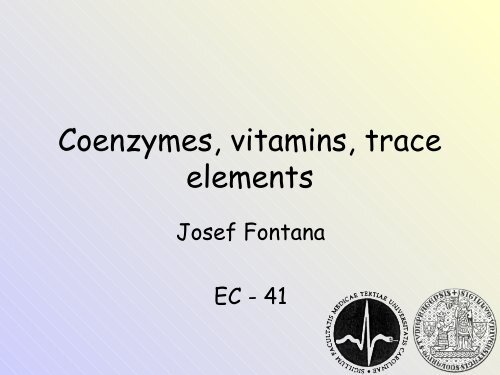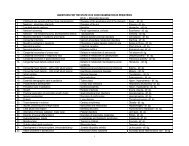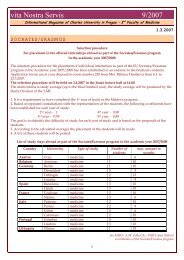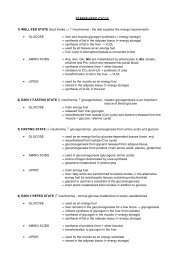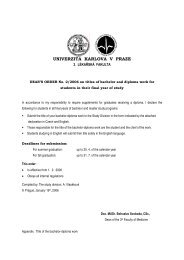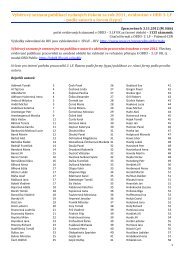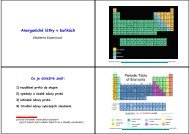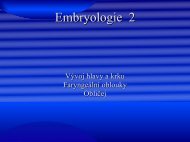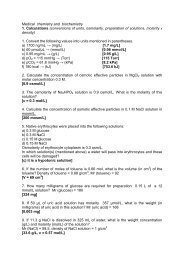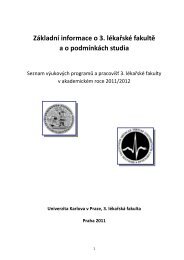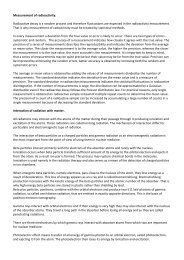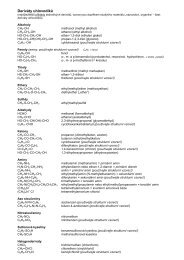You also want an ePaper? Increase the reach of your titles
YUMPU automatically turns print PDFs into web optimized ePapers that Google loves.
<strong>Coenzymes</strong>, <strong>vitamins</strong>, <strong>trace</strong><strong>elements</strong>Josef FontanaEC - 41
Overview of the lecture• Introduction to the topic: cofactors– Revision of the enzyme structure– The interrelationship cofactor - vitamin - <strong>trace</strong> element• Simple enzymes (proteases)• Examples of complex enzymes and function ofcofactors in their molecules– Vitamins as cofactors (decarboxylases,dehydrogenases)– Trace <strong>elements</strong> as cofactors (carbonic anhydrase)– Cofactors of enzyme groups• The importance for doctors - deficiency as adisease / deficiency as a treatment of diseases
Introduction to the topic:cofactorsRevision of the enzymestructure
Structure and properties• most of enzymes are proteinsThe figure is found at: http://fig.cox.miami.edu/~cmallery/255/255enz/enzymology.htm (December 2006)
Enzyme structure• Enzymes are mostly proteins (exception: ribozyme -catalytic active RNA).• Some enzymes in addition to protein componentcontain also non-protein component. According tothis we can divide enzymes into:– Simple enzymes contain only protein (pepsin, trypsin,ribonuclease).– Complex enzymes contain protein and non-proteincomponent = cofactor.• Cofactor is the non-protein part of the enzymemolecule. It is necessary for its catalytic function.Our body can not synthesize them often - therefore,we eat their precursors – e.g. <strong>vitamins</strong>.
Introduction to the topic:cofactorsThe interrelationshipcofactor - vitamin - <strong>trace</strong>element
Cofactor can be• 1) metal ion: Zn 2+ , Mn 2+ , Mg 2+ , Fe 2+ , Cu 2+ (<strong>trace</strong><strong>elements</strong>)• 2) organic molecule:– coenzymes are slightly bound to the enzyme, undergo achemical change and are released from the enzymemolecule, they are derivates of <strong>vitamins</strong> very often:NAD(P) + , FAD, coenzyme Q, ...– prosthetic groups are tightly bound to the enzyme andremain associated with enzyme during the wholereaction: heme, FAD,…• Coenzyme + apoenzyme (inactive protein) →holoenzyme (active enzyme)
The figure is found at:http://stallion.abac.peachnet.edu/sm/kmccrae/BIOL2050/Ch1-13/JpegArt1-13/05jpeg/05_jpeg_HTML/index.htm (December2006)
Simple enzymes (proteases)
Simple enzymes• How looks like the catalytic mechanism ofsimple enzymes ? I show you two examples:• 1) pepsin, which belongs to the aspartateproteases and• 2) chymotrypsin, which belongs to the serineproteases• Neither of them needs to have cofactor forthe hydrolysis. Both need properly arrangedside chains of amino acids in their active site.
How works pepsin• For the pepsin catalytic activity are essential twoaspartates (their side chains) in its active siteand water molecule.• One aspartate attracts proton from watermolecule. Water then attacks the carbonyl group(that forms a peptide bond).
How works pepsin• Catalysis involves two conservedaspartyl residues.• In the first stage of the reaction, anaspartate functioning as a generalbase (Asp X) extracts a proton froma water molecule, making it morenucleophilic.• This resulting nucleophile thenattacks the electrophilic carbonylcarbon of the peptide bond targetedfor hydrolysis, forming a tetrahedraltransition state intermediate.
How works pepsin• A second aspartate (Asp Y) thenfacilitates the decomposition ofthis tetrahedral intermediate bydonating a proton to the aminogroup produced by rupture of thepeptide bond.• The two different active siteaspartates can act simultaneouslyas a general base or as a generalacid because their immediateenvironment favors ionization ofone, but not the other.
How works chymotrypsin• While catalysis by aspartic proteases involves thedirect hydrolytic attack of water on a peptide bond,catalysis by the serine protease chymotrypsininvolves prior formation of a covalent acyl enzymeintermediate.• A highly reactive seryl residue, serine 195,participates in a charge-relay network with histidine57 and aspartate 102.• Far apart in primary structure, in the active sitethese residues are within bond-forming distance ofone another. Aligned in the order Asp 102-His 57-Ser195, they constitute a "charge-relay network" thatfunctions as a "proton shuttle."
How works chymotrypsinCH 2 OHHNCH 2NCH 2 -COOHall these tools come from amino acidsin the protein active site
How works chymotrypsin• Binding of substrate initiatesproton shifts that in effecttransfer the hydroxyl protonof Ser 195 to Asp 102.• The enhanced nucleophilicityof the seryl oxygenfacilitates its attack on thecarbonyl carbon of thepeptide bond of thesubstrate, forming transienttetrahedral intermediate.
How works chymotrypsin• The proton on Asp 102 thenshuttles through His 57 to theamino group liberated when thepeptide bond is cleaved.• The portion of the originalpeptide with a free amino groupthen leaves the active site andis replaced by a water molecule,yielding an acyl-Ser 195intermediate (covalent bondacyl-enzyme).
How works chymotrypsin• The charge-relay network nowactivates the water molecule bywithdrawing a proton through His 57to Asp 102.• The resulting hydroxide ion attacksthe acyl-enzyme intermediate,forming a second tetrahedralintermediate.• The charge-relay system donates aproton to Ser 195 (restoring itsoriginal state), facilitatingbreakdown of tetrahedralintermediate to release the carboxylterminal peptide.
Examples of complex enzymesand function of cofactors intheir moleculesVitamins as cofactors(decarboxylases,dehydrogenases)
Vitamins• Name derives from the Latin word Vita =Life• Vitamins soluble in water:• Vitamin C• B complex: B1, B2, B3, B6, folic acid (B9), B12,niacin (PP), biotin, pantothenoic acid• Fat-soluble <strong>vitamins</strong>: Vitamin A, D, E, K
B1 Thiamine• Active cofactor is thiaminepyrophosphate - TPP (produced by TPPsynthetase)• TPP is a cofactor in oxidativedecarboxylation of pyruvate and alphaketoglutarate.• In addition, TPP is used in transketolasereactions (pentose phosphate pathway).
Thiamine → TPP
Thiamine pyrophosphate• The key part of the cofactor molecule is thiazole ring withits acidic hydrogen.• Hydrogen is removed by the enzyme, forming carbanion.Molecule is called ylide (contains anion next to the cation).• Anion can then react with the carbonyl group in differentmolecules (e.g. pyruvate).• Pyrophosphate works as a handle, which holds the cofactorin proper place within the enzyme molecule.
Thiamine pyrophosphate• The key part of thecofactor molecule isthiazole ring withits acidic hydrogen.• Hydrogen isremoved by theenzyme, formingcarbanion. Moleculeis called ylide(contains anion nextto the cation).
Thiamine pyrophosphate• TPP catalyses the cleavage of asubstrate compound at a carbon-carbonbond connecting a carbonyl group to anadjacent reactive group (usually acarboxylic acid or an alcohol).• It achieves this in four basic steps.
Thiamine pyrophosphateClNCH 3HClNCH 3OOO-HSSpyruvate• 1) The carbanion ofthe TPP ylidnucleophilicallyattacks the carbonylgroup on thesubstrate.• This forms a singlebond between the TPPand the substrate.acidic hydrogenClNOHNSCH 3resonanceH +ylid- CO 2HOOClClNO-CH 3SCH 3CH 3 NSOHSOHHO+ ylidH 3 CHacetaldehyde
Thiamine pyrophosphateClNCH 3HClNCH 3OOO-HSSpyruvate• 2) The target bond onthe substrate is broken,and its electrons arepushed towards the TPP.• This creates a doublebond between thesubstrate carbon and theTPP carbon and pushesthe electrons in the N-Cdouble bond in TPPentirely onto thenitrogen atom, reducingit from a positive toneutral form.acidic hydrogenClNSOHNSOHylidCH 3- CO 2HOOresonanceClCH 3 NH +SOHHOClNSO-CH 3+ ylidCH 3H 3 CHacetaldehyde
Thiamine pyrophosphateClNCH 3HClNCH 3OOO-HSSpyruvate• 3) The electrons pushback in the oppositedirection forming a newbond between thesubstrate carbon andhydrogen proton.• 4) The TPP-substratebond is broken, reformingthe TPP ylid and thesubstrate carbonyl(decarboxylatedsubstrate) is transferredon the target molecule(e.g. lipoamide).acidic hydrogenClNSOHNSOHylidCH 3- CO 2HOOresonanceClCH 3 NH +SOHHOClNSO-CH 3+ ylidCH 3H 3 CHacetaldehyde
thiazolium ringNH 2HNNCSH 3 CNH 3 CH 2 COH 2C O POOP O-O-O-thiamine pyrophosphateHNH 2H 3 CCOHNNCSH 3 CNH 3 CH 2 COH 2C O POOP O-Hydroxyethyl thiamine pyrophosphateO-O-
Lipoic acid• Lipoic acid is a co-factor found in pyruvatedehydrogenase and α-ketoglutaratedehydrogenase and two multienzymes involvedin α-keto acid oxidation.• Lipoic acid couples acyl group transfer andelectron transfer during oxidation anddecarboxylation of α-ketoacids.• No evidence exists of a dietary lipoic acidrequirement in humans. Therefore it is notconsidered to be a vitamin.
SSSHHSH 2 CCH 2CHCOOHH 2 CCH 2CHCOOHlipoic acid, oxidized formlipoic acid, reduced formSSHH 2 CCH 2CHCONCHCNHOlipoamide complex (lipoyl-lysine conjugate)Lipoic acid exists in 2 forms: a closed-ring disulfide form andan open-chain reduced form; oxidation-reduction cycles interconvertthese 2 species; lipoic acid exists covalently attached in an amidelinkage with lysine residues on enzymes
B2 Riboflavin• It forms 2 cofactors :• flavin mononucleotide, FMN• flavin adenine dinucleotide,FAD• Involved in the metabolismof carbohydrates, fats andproteins (flavindehydrogenases /flavoproteins).• Hydrogen carriers in therespiratory chainH 3 CH 3 CH 2 C OHH C OHH C OHH C OHH C HN NNORIBOFLAVINNOH
RiboflavinHH 3 CNNOH 3 CNNOH 3 CNNHH 3 CNNHOFAD (oxidized form)hydrogen additionoccurs in 2 stepsHOFADH 2 (reduced form)
Succinate dehydrogenaseCO 2 -CH 2succinatedehydrogenaseCO 2 -CHCH 2HCCO 2 - FAD FADH 2succinateCO 2 -fumarate
Xanthine oxidaseOHOHOHNNNNNNNNHO NNHO NNHHHhypoxanthine xanthine uric acidOHxanthine oxidaseXanthine oxidase is a flavoprotein which also contains Fe and Mo – <strong>trace</strong> <strong>elements</strong>
Examples of complex enzymesand function of cofactors intheir moleculesTrace <strong>elements</strong> as cofactors(carbonic anhydrase)
Trace <strong>elements</strong>• Present in human body in amount less than1mg/kg.• I, Zn, Cu, Se, Cr, F, Mn, Co, Mo• Have known biological function (prostheticgroups).• Deficiencies are huge problem in developingcountries.• But also specific risk groups: the homeless,alcoholics and patients on total parenteralnutrition (TPN)
Carbonic anhydrase• Catalyzes the reaction:• The active site contains zinc.
Carbonic anhydrase• A zinc prosthetic groupin the enzyme is held by3 histidine side-chains.The fourth coordinationposition is occupied bywater.• This causes polarisationof the hydrogen-oxygenbond in water, making theoxygen slightly morenegative, therebyweakening the bond.
Carbonic anhydrase• A fourth histidine is placedclose to the substrate ofwater and accepts a proton.This leaves a hydroxideattached to the zinc.• The active site also containsspecificity pocket for carbondioxide, bringing it close tothe hydroxide group. Thisallows the electron richhydroxide to attack thecarbon dioxide, formingbicarbonate.• Bicarbonate is replaced witha new water molecule.
Examples of complex enzymesand function of cofactors intheir moleculesCofactors of enzyme groups
Cofactors help to catalyze manyreactions• Cofactors of oxidoreductases: NAD(P) + ,FAD, cytochromes (contain heme), Fe-Scomplexes• <strong>Coenzymes</strong> carrying C1 radicals:tetrahydrofolate, vitamin B12, S-adenosylmethionine, biotin (cofactor ofcarboxylases)• Cofactors carrying acyl: lipoic acid (PDHprosthetic group, α-KGDH) HSCoA,pyridoxal phosphate (transaminases)
Cofactors of oxidoreductasesNAD + nicotinamide adenine dinucleotideNADP + nicotinamide aden. dinucl. phosphate(precursor: niacin = nicotinic acid) H+FAD flavin adenine dinucleotideFMN flavin mononucleotide(precurzor: riboflavin = vitamin B2) 2 H+heme Fe 3+ + e - ↔ Fe 2+ ⇒ e -
Cofactors of transferasesATP adenosine triphosphate / phosphateGTP guanosine triphosphate / phosphateTDP thiamine diphosphate / C-fragment(prekurzor: thiamine = vitamin B1)PALP pyridoxal phosphate / -NH 2(prekurzor: pyridoxine = vitamin B6)THF tetrahydrofolate / C1-fragment(prekurzor: folic acid)CoA coenzyme A (HS-Co-A) / acylPAPS phosphoadenosine phosphosulfate / sulfate
Cofactors ofLyases:PALP pyridoxal phosphate (decarboxylases)Ligases:ATP adenosine triphosphate→ acyl-CoA-synthetases→ aminoacyl-tRNA-synthetasesbiotin= vitamin H (carboxylases)
<strong>Coenzymes</strong> and prosthetic groupNAD + ↔ NADH + H + FAD ↔ FADH 2nicotinamide adenine dinucleotide flavin adenine dinucleotide(vit. B2 = riboflavin)coenzymeprosthetic gr.Other examples: coenzyme A, coenzyme Q, tetrahydrofolate, thiaminediphosphate (vit. B1 = thiamine)http://web.indstate.edu/thcme/mwking/<strong>vitamins</strong>.html
Prosthetic groupsBiotin (vit. H)Heme• Another example: pyridoxal phosphate (derivateof vitamin B6)http://web.indstate.edu/thcme/mwking/<strong>vitamins</strong>.html
The importance for doctors -deficiency as a disease / deficiencyas a treatment of diseases
B9 Folic Acid• Folic acid is composed of pteridine, P-amino benzoic acid,and glutamic acid.• Its derivate is tetrahydrofolate. It can carry one-carbonfragments (involved in the methylation reactions).
Folate deficiency causesmegaloblastic anemia• N5, N10-methylene-tetrahydrofolate carriesmethyl group into the thymine synthesis(necessary for DNA synthesis and thus alsofor the formation of erythrocytes).• Deficiency of folic acid affects cells that aredividing rapidly because they have a largerequirement for thymidine for DNA synthesis.• Clinically, this affects the bone marrow,leading to megaloblastic anemia.
Lack of folate can treat tumors• During the thimine synthesis there are severalchanges in the N5, N10-methylene-THF molecule.• The methylene group is reduced to the methyl groupthat is transferred, and tetrahydrofolate is oxidizedto dihydrofolate.• For further pyrimidine synthesis to occur,dihydrofolate must be reduced back totetrahydrofolate, a reaction catalyzed bydihydrofolate reductase.• Dividing cells, which must generate thymidine anddihydrofolate, thus are especially sensitive toinhibitors of dihydrofolate reductase such as theanticancer drug methotrexate.
Lack of folate can treatinfections• Human body can not produce its ownTHF, while pathogenic bacteria havethis ability.• This is used in the treatment ofbacterial diseases withsulphonamides.• They are in fact for bacteriaindistinguishable similar to p-aminobenzoic acid.• Bacteria try to incorporatesulphonamides into THF molecules,but the result is a dysfunctionalcofactor.• Sulfonamides are the competitiveinhibitors of enzymes involved insynthesis of THF.


